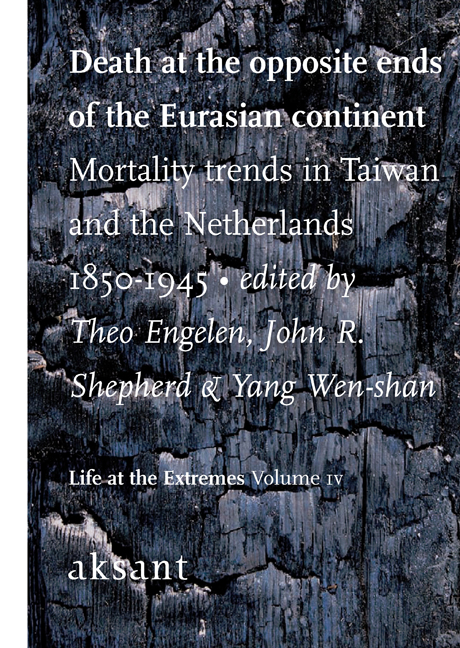 Death at the Opposite Ends of the Eurasian Continent
Death at the Opposite Ends of the Eurasian Continent Published online by Cambridge University Press: 22 January 2021
Introduction
This paper explores trends in mortality and causes of death in colonial Taiwan primarily through the study of patterns of mortality by age and sex for selected leading causes of death. The discussion concentrates on the following causes of death in the period 1905-1942: malaria, respiratory tuberculosis, respiratory diseases, diarrhea and enteritis, and infant causes. Note that due to an early Japanese period vaccination campaign, smallpox was no longer a leading cause by 1905 when our data series begins (Shepherd 2001). There is not space to treat other causes, many of them the source of important epidemics (e.g., plague, influenza, cholera), but less important to the patterns of mortality overall.
Important early studies of causes of death in Taiwan come from Li T’engyueh (1938), George W. Barclay (1954), and Chen Shao-hsing (1955). Ensuring the consistent definition of cause categories, and a minimum quality of diagnostic skill by those making the determinations of cause is a prerequisite to the use of cause of death reports. Issues of reporting quality in the Taiwan cause of death reports are discussed in detail in the Appendix. The data series for several causes appear to be inconsistently reported between the early years when reporting quality was low and the later years. Such inconsistencies arise from improving diagnostics and training on the part of personnel filling out death certificates, and also changes in the definitions of disease categories (and also rules for deciding between two or more contributing causes). Previous studies of trends in causes of death in Japanese period Taiwan have failed to take into account these inconsistencies (e.g., Chen 1955). In the discussion below of specific causes, those reported inconsistently in the early years will be reported only for the years 1924-41, when the third and fourth international cause of death lists were used to compile the cause of death reports, and reporting quality was highest.
There are two causes, however, malaria and respiratory tuberculosis, that appear to provide relatively consistently reported series for more extended periods. These causes of death present symptoms relatively easy for certifiers to identify, periodic chills and fevers and swollen spleens in the case of malaria, and bloody sputum in the case of respiratory tuberculosis. The international lists for compiling death statistics in use by the colonial authorities also consistently reserved separate categories specific to these causes, which immunized them from inconsistencies arising from changing category definitions.
To save this book to your Kindle, first ensure [email protected] is added to your Approved Personal Document E-mail List under your Personal Document Settings on the Manage Your Content and Devices page of your Amazon account. Then enter the ‘name’ part of your Kindle email address below. Find out more about saving to your Kindle.
Note you can select to save to either the @free.kindle.com or @kindle.com variations. ‘@free.kindle.com’ emails are free but can only be saved to your device when it is connected to wi-fi. ‘@kindle.com’ emails can be delivered even when you are not connected to wi-fi, but note that service fees apply.
Find out more about the Kindle Personal Document Service.
To save content items to your account, please confirm that you agree to abide by our usage policies. If this is the first time you use this feature, you will be asked to authorise Cambridge Core to connect with your account. Find out more about saving content to Dropbox.
To save content items to your account, please confirm that you agree to abide by our usage policies. If this is the first time you use this feature, you will be asked to authorise Cambridge Core to connect with your account. Find out more about saving content to Google Drive.